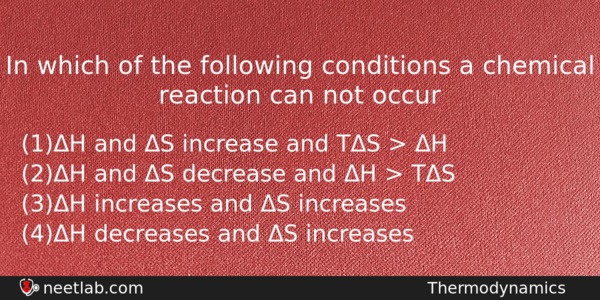| ⇦ | 
| ⇨ |
In which of the following conditions a chemical reaction can not occur
Options
(a) ΔH and ΔS increase and TΔS > ΔH
(b) ΔH and ΔS decrease and ΔH > TΔS
(c) ΔH increases and ΔS increases
(d) ΔH decreases and ΔS increases
Correct Answer:
ΔH increases and ΔS increases
Explanation:
(i)When ΔH and ΔS increase, then , if TΔS > ΔH the reaction is spontaneous.
Therefore ΔG = ΔH – TΔS = -ve.
(ii)When ΔH and ΔS decrease,then if ΔH > TΔS. This makes ΔG is -ve and process is spontaneous.
(iii) If , ΔH increases and ΔS decreases, then ΔG is +ve and process is non-spontaneous.
(iv) If ΔH decrease and ΔS increases, then ΔG is -ve and process is spontaneous.
Related Questions: - A deutrium is
- Ozone in stratosphere is depleted by
- Isotonic solution have the same
- 6.02 x 10²° molecules of urea are present in 100 mL of its solution
- The wrong statements about glycerol is
Topics: Thermodynamics
(179)
Subject: Chemistry
(2512)
Important MCQs Based on Medical Entrance Examinations To Improve Your NEET Score
- A deutrium is
- Ozone in stratosphere is depleted by
- Isotonic solution have the same
- 6.02 x 10²° molecules of urea are present in 100 mL of its solution
- The wrong statements about glycerol is
Topics: Thermodynamics (179)
Subject: Chemistry (2512)
Important MCQs Based on Medical Entrance Examinations To Improve Your NEET Score
18000+ students are using NEETLab to improve their score. What about you?
Solve Previous Year MCQs, Mock Tests, Topicwise Practice Tests, Identify Weak Topics, Formula Flash cards and much more is available in NEETLab Android App to improve your NEET score.
Share this page with your friends

Leave a Reply